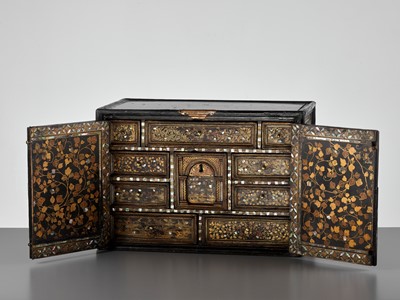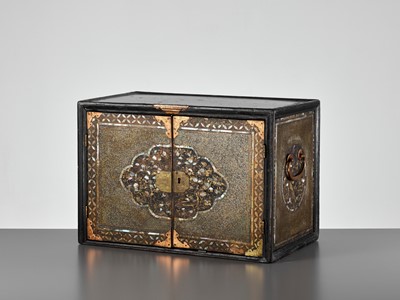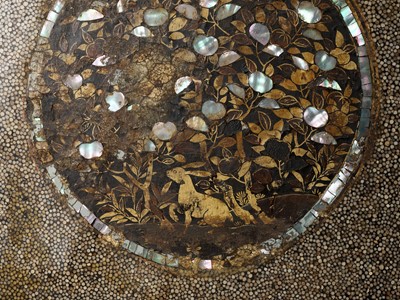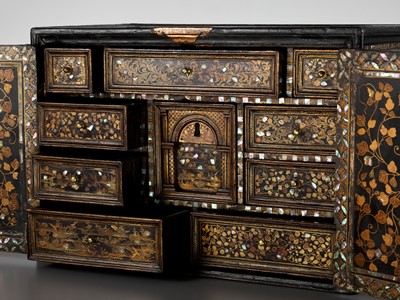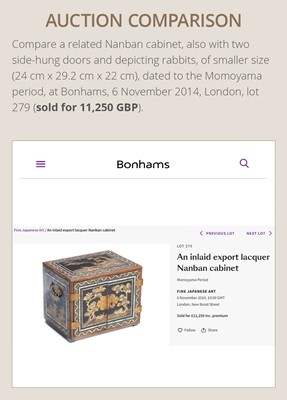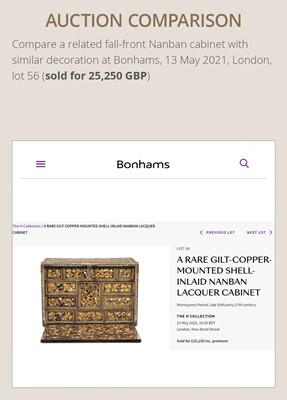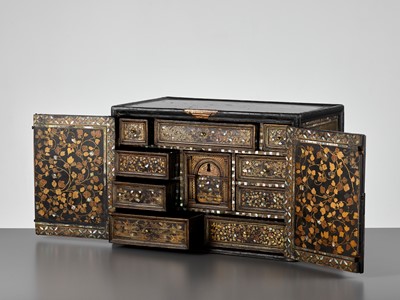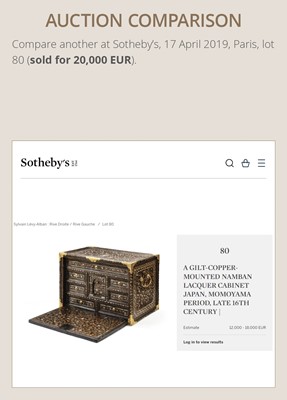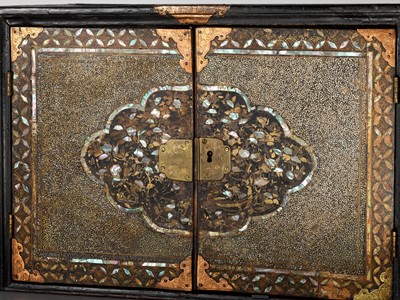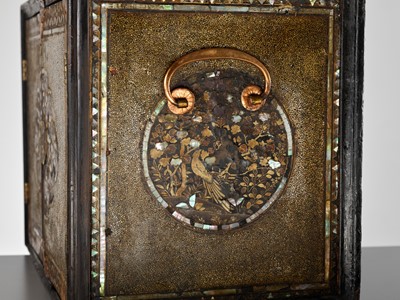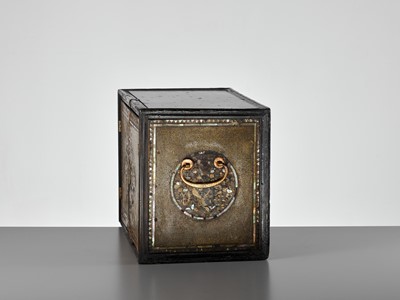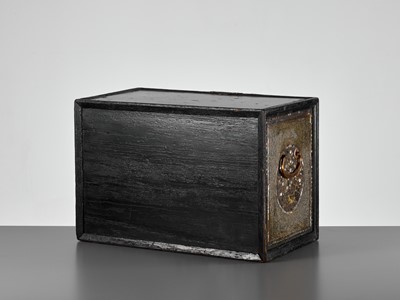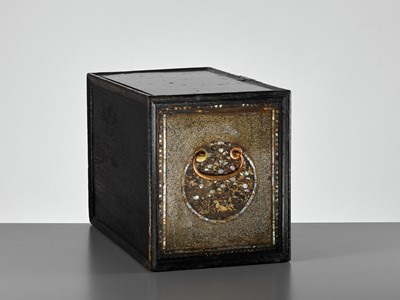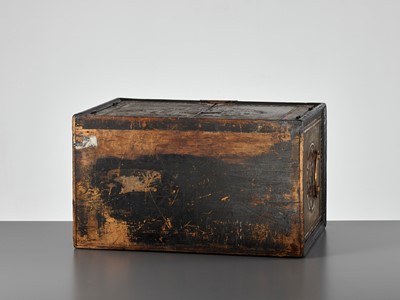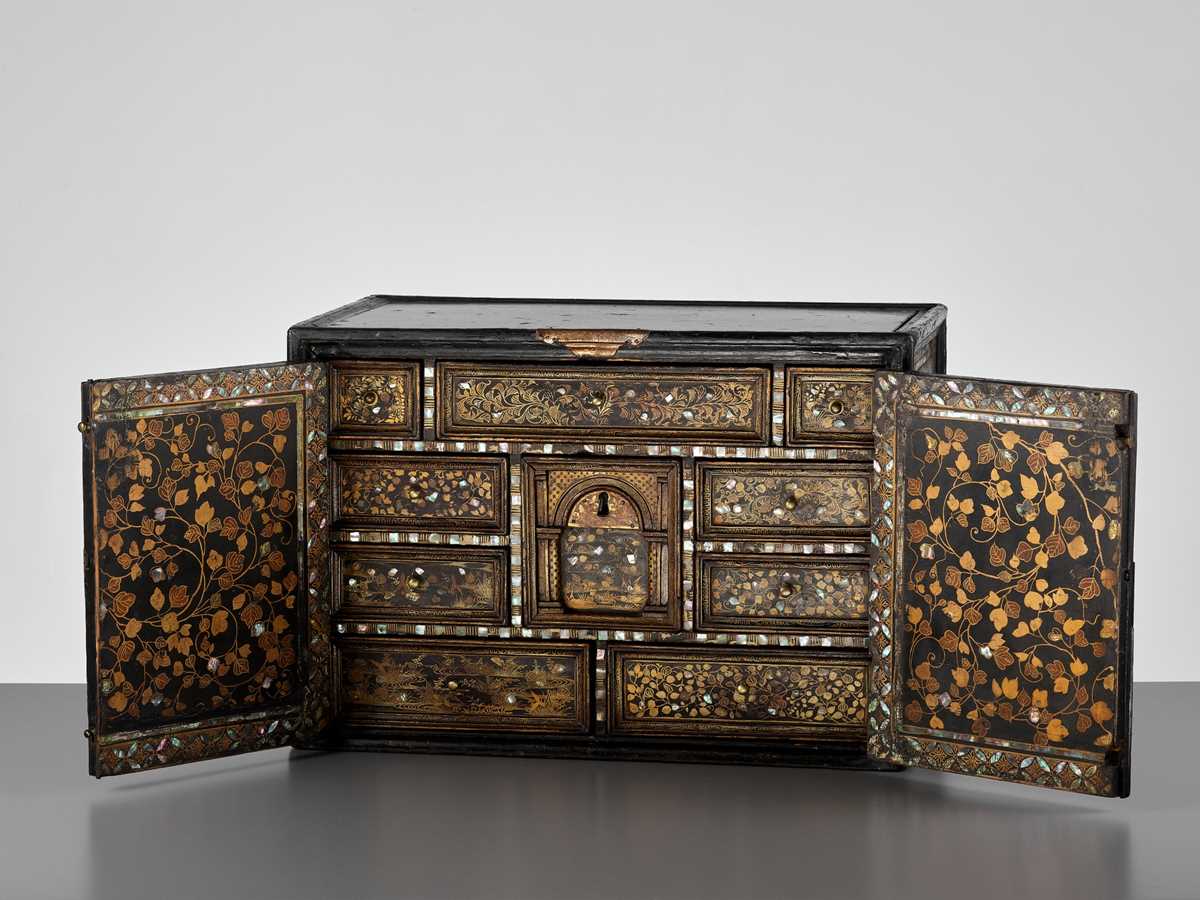16th Jun, 2023 11:00
Fine Japanese Art
1
A RARE SHELL-INLAID NANBAN LACQUER CABINET
Sold for €15,600
including Buyer's Premium
Japan, late 16th to early 17th century, Momoyama (1573-1615) to early Edo period (1615-1868)
Of wide rectangular form with two side-hung doors, one with a keyhole, which open to reveal the interior typically fitted with ten drawers of varying size, arranged symmetrically in rows. The doors and sides richly decorated in gold hiramaki-e and mother-of-pearl inlays on the black-lacquered wood, the front with a shaped panel enclosing a ho-o bird amid dense leafy floral blossoms, reserved against by a minutely inlaid dotted ground, surrounded by a shippo-tsunagi (linked-cash) border, the sides similarly decorated with circular panels enclosing a rabbit and bird, respectively, each surrounded by a diapered border. The backs of the doors and fronts of the drawers similarly lacquered and inlaid with scrolling foliage and swirling ponds.
SIZE 35.9 x 52.1 x 30.2 cm
Condition: Good condition, commensurate with age. Extensive wear, age cracks, losses to inlay and lacquer, old repairs, touchups, nicks, scratches, some fittings possibly renewed.
In the late sixteenth century, Japanese lacquer makers had a global clientele and vied to come up with innovative designs. They produced portable desks with drawers, such as this one, for the European, and especially the Portuguese, market. The style is known as nanban (literally, “southern barbarian”), meaning foreign.
Crafted in Kyoto's lacquer workshops alongside quite different wares intended for elite Japanese clients, these kinds of Nanban coffers and cabinets decorated in gold hiramaki-e and shell were among the earliest Japanese artefacts to reach Asian and European markets, starting two or three decades after the first landfall by Portuguese adventurers in the mid-sixteenth century. Celebrated today for their lavish, innovative technique and dense ornamentation (inspired in part by wares from other parts of Asia), such pieces brought the Japanese genius for design to global attention and ensured that Japan would be synonymous with 'lacquer' until the present day.
Auction comparison:
Compare a related Nanban cabinet, also with two side-hung doors and depicting rabbits, of smaller size (24 cm x 29.2 cm x 22 cm), dated to the Momoyama period, at Bonhams, 6 November 2014, London, lot 279 (sold for 11,250 GBP). Compare also a related fall-front Nanban cabinet with similar decoration at Bonhams, 13 May 2021, London, lot 56 (sold for 25,250 GBP) and another at Sotheby’s, 17 April 2019, Paris, lot 80 (sold for 20,000 EUR).
Japan, late 16th to early 17th century, Momoyama (1573-1615) to early Edo period (1615-1868)
Of wide rectangular form with two side-hung doors, one with a keyhole, which open to reveal the interior typically fitted with ten drawers of varying size, arranged symmetrically in rows. The doors and sides richly decorated in gold hiramaki-e and mother-of-pearl inlays on the black-lacquered wood, the front with a shaped panel enclosing a ho-o bird amid dense leafy floral blossoms, reserved against by a minutely inlaid dotted ground, surrounded by a shippo-tsunagi (linked-cash) border, the sides similarly decorated with circular panels enclosing a rabbit and bird, respectively, each surrounded by a diapered border. The backs of the doors and fronts of the drawers similarly lacquered and inlaid with scrolling foliage and swirling ponds.
SIZE 35.9 x 52.1 x 30.2 cm
Condition: Good condition, commensurate with age. Extensive wear, age cracks, losses to inlay and lacquer, old repairs, touchups, nicks, scratches, some fittings possibly renewed.
In the late sixteenth century, Japanese lacquer makers had a global clientele and vied to come up with innovative designs. They produced portable desks with drawers, such as this one, for the European, and especially the Portuguese, market. The style is known as nanban (literally, “southern barbarian”), meaning foreign.
Crafted in Kyoto's lacquer workshops alongside quite different wares intended for elite Japanese clients, these kinds of Nanban coffers and cabinets decorated in gold hiramaki-e and shell were among the earliest Japanese artefacts to reach Asian and European markets, starting two or three decades after the first landfall by Portuguese adventurers in the mid-sixteenth century. Celebrated today for their lavish, innovative technique and dense ornamentation (inspired in part by wares from other parts of Asia), such pieces brought the Japanese genius for design to global attention and ensured that Japan would be synonymous with 'lacquer' until the present day.
Auction comparison:
Compare a related Nanban cabinet, also with two side-hung doors and depicting rabbits, of smaller size (24 cm x 29.2 cm x 22 cm), dated to the Momoyama period, at Bonhams, 6 November 2014, London, lot 279 (sold for 11,250 GBP). Compare also a related fall-front Nanban cabinet with similar decoration at Bonhams, 13 May 2021, London, lot 56 (sold for 25,250 GBP) and another at Sotheby’s, 17 April 2019, Paris, lot 80 (sold for 20,000 EUR).
Zacke Live Online Bidding
Our online bidding platform makes it easier than ever to bid in our auctions! When you bid through our website, you can take advantage of our premium buyer's terms without incurring any additional online bidding surcharges.
To bid live online, you'll need to create an online account. Once your account is created and your identity is verified, you can register to bid in an auction up to 12 hours before the auction begins.
Intended Spend and Bid Limits
When you register to bid in an online auction, you will need to share your intended maximum spending budget for the auction. We will then review your intended spend and set a bid limit for you. Once you have pre-registered for a live online auction, you can see your intended spend and bid limit by going to 'Account Settings' and clicking on 'Live Bidding Registrations'.
Your bid limit will be the maximum amount you can bid during the auction. Your bid limit is for the hammer price and is not affected by the buyer’s premium and VAT. For example, if you have a bid limit of €1,000 and place two winning bids for €300 and €200, then you will only be able to bid €500 for the rest of the auction. If you try to place a bid that is higher than €500, you will not be able to do so.
Online Absentee and Telephone Bids
You can now leave absentee and telephone bids on our website!
Absentee Bidding
Once you've created an account and your identity is verified, you can leave your absentee bid directly on the lot page. We will contact you when your bids have been confirmed.
Telephone Bidding
Once you've created an account and your identity is verified, you can leave telephone bids online. We will contact you when your bids have been confirmed.
Classic Absentee and Telephone Bidding Form
You can still submit absentee and telephone bids by email or fax if you prefer. Simply fill out the Absentee Bidding/Telephone bidding form and return it to us by email at office@zacke.at or by fax at +43 (1) 532 04 52 20. You can download the PDF from our Upcoming Auctions page.
How-To Guides
How to Create Your Personal Zacke Account
How to Register to Bid on Zacke Live
How to Leave Absentee Bids Online
How to Leave Telephone Bids Online
中文版本的操作指南
创建新账号
注册Zacke Live在线直播竞拍(免平台费)
缺席投标和电话投标
Third-Party Bidding
We partner with best-in-class third-party partners to make it easy for you to bid online in the channel of your choice. Please note that if you bid with one of our third-party online partners, then there will be a live bidding surcharge on top of your final purchase price. You can find all of our fees here. Here's a full list of our third-party partners:
- 51 Bid Live
- EpaiLive
- ArtFoxLive
- Invaluable
- LiveAuctioneers
- the-saleroom
- lot-tissimo
- Drouot
Please note that we place different auctions on different platforms. For example, in general, we only place Chinese art auctions on 51 Bid Live.
Bidding in Person
You must register to bid in person and will be assigned a paddle at the auction. Please contact us at office@zacke.at or +43 (1) 532 04 52 for the latest local health and safety guidelines.
